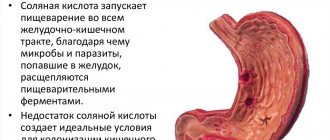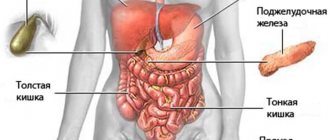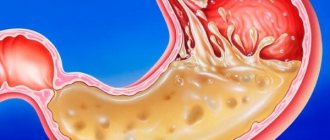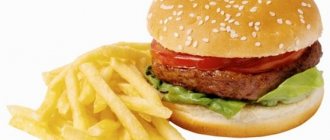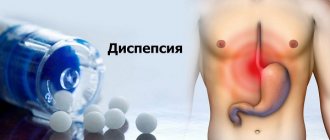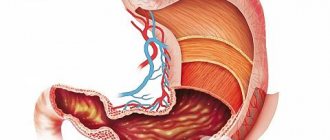Gastric acidity is measured in pH and characterizes the concentration of acid in the stomach. Shifts in indicators make it possible to determine the presence or absence of diseases in the gastrointestinal tract and generally assess the state of health.
Hydrochloric acid plays the main role in the acidity level; other acids in the stomach are present in minimal quantities. The appearance of lactic acid indicates that the process of secretion of hydrochloric acid is disrupted in the body, therefore, its level is reduced to a minimum and stomach cancer may have already begun. Determining acidity is an important point for making an adequate diagnosis. It is recommended to conduct studies of acid levels in different parts of the gastrointestinal tract, from the stomach to the duodenum.
Changes in microscopic examination of gastric juice
To assess certain properties of gastric juice, various methods are used.
The most common methods include intragastric pH-metry and direct examination of the contents of the stomach after its removal using a probe.
Sometimes so-called fractional sounding is used. In this case, the first portion of gastric juice is taken on an empty stomach, and the second after the so-called test breakfast, which stimulates secretion.
Normally, gastric juice may contain elements of the mucous membrane of the stomach or overlying parts of the digestive tract, undigested food debris and microorganisms, as well as mucus.
An increase in the amount of mucus in the gastric juice can be observed with peptic ulcers, gastritis, polyposis or stomach cancer.
If lactic acid bacilli, sorcinol, droplets of fat, and yeast proteins are found in the gastric juice, then this is interpreted as signs of stagnation of gastric juice.
The detection of atypical cells in the gastric juice is characteristic of the initial stages of the development of malignant tumors.
Detection of leukocytes higher than 0.3*109 indicates an inflammatory process in the stomach.
The study of gastric juice is carried out in humans using gastric intubation against the background of the use of various natural and pharmacological stimuli, in animals - using artificially created according to improved I.P. Pavlov's method of isolated ventricle. Gastric juice obtained from animals was used internally in the treatment of certain diseases of the digestive system. Bicarbonates
HCO3 bicarbonates are necessary to neutralize hydrochloric acid at the surface of the mucous membrane of the stomach and duodenum in order to protect the mucosa from the effects of acid. Produced by superficial accessory (mucoid) cells. The concentration of bicarbonates in gastric juice is 45 mmol / l.
Pepsinogen and pepsin
Pepsin is the main enzyme that breaks down proteins. There are sprat isoforms of pepsin, each of which affects its own class of proteins. Pepsin is released from pepsinogens when the latter enter an environment with a certain acidity. The main cells of the fundic glands are responsible for the production of pepsinogens in the stomach.
Mucus is the most important factor in protecting the gastric mucosa. The mucus forms a mixed layer of gel, about 06 mm thick, which concentrates bicarbonates, which neutralize the acid and thereby protect the mucous membrane from the damaging effects of hydrochloric acid and pepsin. Produced by superficial accessory cells.
Castle's internal factor
What is the environment in the stomach of a healthy person?
The human stomach is not healthy
Can stress cause stomach ulcers? In general, ulcers and erosion are the result of Helicobacter pylori.
But nevertheless, the disease is called peptic ulcer, i.e. formed from pepsin; in the absence of pepsin or hydrochloric acid, it usually does not develop. And stress plays its part in this phenomenon.
The fact is that 85% of the population is infected with this bacterium, which leads to erosions, ulcers and oncology. But all these 85% are not cured. If a person has no pain, there is no problem, he does not go to the doctor. If there is pain, the doctor will send you for a gastroscopy and prescribe antibiotics (if Helicobacter is detected on the biopsy).
And then he looks: if there is a relapse (return of this state), then he will then proceed from this. What if there is no pain? A person walks around with this, and then walks around for himself. But Helicobacter pylori is a factor in the development of stomach ulcers. And if there are no complaints, such people are still treated with an antibiotic as a prophylaxis against erosions and ulcers.
Healthy human stomach
But I chose the second method for myself - a method without chemicals. Each pathogen has its own frequency fluctuation . This is how, for example, frequencies act on rodents and insects.
For example , the same Helicobacter pylori dies if it is exposed to successive frequencies of 2950.0 Hz (Hertz, if anyone doesn’t know, this is a physical quantity); 2819.0 Hz; 2779.0 Hz; 2167.0 Hz; 880.0 Hz; 728.0Hz; 705.0 Hz; 695.0 Hz; 676.0 Hz; 352.0 Hz and 347.0 Hz.
After this, you need to carry out cell regeneration, which is achieved by exposure to frequencies of 97.5 Hz and 111 Hz on the beta wave and is similar to the production of endorphins (hormones of happiness and satisfaction).
Moreover, the time for each frequency should be 5 minutes. Then there is a therapeutic effect. How pathogens die under the influence of frequencies, for example, oral amoeba, and more about this harmless and effective treatment can be found here.
After that, you just need to stick to your diet to feel great for many years.
I can say this to those who take pills. Omeprazole is the founder of anti-Helicobacter therapy. Many drugs are now based on it.
The situation is called a vicious circle .
You can’t not take it, because everything comes back when you stop drinking it. But due to long-term use, it leads to disturbances in the absorption of calcium and disturbances in the absorption of vitamin B12. Hence the softening of bones, allergies, exhaustion of the nervous system, when you can no longer react normally to an ordinary situation.
Remember that it is never too late to take pills.
If a person has nowhere to go, for example, his blood pressure is high, then this is a different matter. In our situation, we have a large reserve of time in order not to start taking pills.
Better start something else - take care of yourself). Anyone interested in this information, please contact me by email or using the feedback form here.
Doctor's consultation is free via Skype, Whatsapp/Viber messengers. Engineer consultation is also free . The cost of such a device is $400-450 at the exchange rate.
Compound
Colorless, strongly acidic (pH 1-1.5 in humans), slightly opalescent liquid. Gastric juice contains 99.4% water (H 2 O), in which the main components are dissolved - enzymes, hydrochloric acid and lucoids.
The main inorganic component of gastric juice is hydrochloric acid in a free and protein-bound state. The composition also includes chlorides, phosphates, sulfates, sodium carbonates, potassium, calcium, etc.
Among the organic compounds are proteins, mucin (mucus), lysozyme, enzymes (enzymes) pepsin, metabolic products.
Hydrochloric acid activates enzymes, facilitates the breakdown of proteins, causing their denaturation and swelling, determines the bactericidal properties of gastric juice (prevents the development of putrefactive processes in the stomach), and stimulates the release of intestinal hormones. In some disorders of gastric function, the content of hydrochloric acid in gastric juice may increase or decrease until it is completely absent (tachilia).
Healthy stomach
To have a healthy stomach, you will learn:
- Listen to short music to regenerate and restore stomach cells.
- Find out which of you has a real problem.
- How to kill Helicobacter without harm and medications, so as not to become addicted to them for life.
- Why don't enzymes help?
- Why do pills help temporarily?
- How to treat real dysbiosis.
- Choose your own way to maintain a healthy stomach.
Stomach health
While you are reading this article, do not waste time, turn on the video (it is not necessary to watch) and let the cells of your body regenerate (restore). Nervous ones too.
This music is superimposed with a cell regeneration frequency of 111 Hz on the beta wave, similar to the production of endorphins (hormones of happiness and satisfaction).
Regeneration and restoration of cells 5 min. 37 sec.
Abdominal pain, heartburn, belching, bloating... Every fourth patient consults a general practitioner with these problems. 25% of people who come to the doctor come with this very problem of maintaining a healthy stomach.
The therapist sends them to a gastroenterologist. Of these people, in 75% of cases, gastroenterologists find nothing in terms of examinations (gastroscopy, etc.).
Only 25% of those who apply have a real problem. A question immediately arises.
What should other people do and what kind of disease do they have in this case? We constantly try to get around this issue for aesthetic reasons. But a person suffers from constipation, heartburn, gas, pain...
Studies show that the volume of gas formation per day in such cases is 1.5 - 2 liters of gas. It's a lot. And the doctors are right when they say that you need to stick to a diet. We all know well the foods that contribute to gas formation:
- cabbage, which everyone loves;
- legumes;
- many meat products.
Secretion of gastric juice
The secretion of gastric juice is determined in the first, complex reflex phase of secretion by the sight, smell and taste of food; in the second, neuro-humoral phase - chemical and mechanical irritations of the gastric mucosa. A person secretes up to 2 liters of gastric juice per day. The quantity, composition and properties of gastric juice vary depending on the nature of the food, as well as in diseases of the stomach, intestines, and liver.
The actual process of secreting gastric juice is activated when peptides are in the stomach and the hormone gastrin begins to enter the blood, which induces the gastric glands to secrete gastric juice.
How to keep a healthy stomach
So , the first way to maintain a healthy stomach is to set limits on the consumption of such foods.
Those anti-gas medications that are advertised on TV - they actually don't do anything. They just kill the smell. Only 1% of these drugs neutralize this.
But this problem is not medicinal. But many young people who really suffer (including morally) from gas formation are completely on such pills.
What will happen to them next if they take these pills all the time? And then they will get fatter, they will blow even more and all this will go on like a snowball. If they don't pull themselves together today...
Such people have a high diaphragm; they also have poor digestion of food; and they also develop a persistent cough, seemingly for no reason. This is all from a high diaphragm. What if there is also pain, if you can’t eat almost anything? What if you get nervous and start to feel pain?
Change in the amount of pepsin
Gastric juice taken on an empty stomach is used for analysis. Its normal amount is 5-40 ml.
Possible causes of increased secretion of gastric juice:
- increased production of gastric juice by stomach cells (with hyperacid gastritis or peptic ulcer, etc.)
- stagnation of stomach contents (spasm or narrowing of the pylorus, stomach tumors)
- reflex increase in the amount of gastric juice in acute appendicitis, cholecystitis
The main manifestations of low acidity
Weak acid-forming function is often caused by abnormalities in metabolic processes. Very often this can be observed in older people. Their metabolism is greatly slowed down, and hormonal imbalances occur. The main symptoms of a decrease in the level of subacidity can be considered:
- Pain and heaviness in the stomach after eating food. A lack of HCl does not allow nutrients to be absorbed normally; its content needs to be increased.
- Belching with an unpleasant odor.
- Taste of blood in the mouth.
- Stool abnormalities - low HCl levels create an alkaline environment for bacteria to grow.
- Pain in the intestines and flatulence - a lack of intestinal enzymes develops and a fermentation process occurs.
Change in color and odor of gastric juice
Normally, colorless gastric juice can acquire the following color:
- yellowish-green in case of bile admixture
- brown - due to an admixture of blood that has been in the stomach for a long time
- streaks of blood in the gastric juice are usually the result of damage to the mucous membrane or bleeding from the upper respiratory tract
The smell of gastric juice is normally practically absent. If gastric juice develops a putrid, unpleasant odor, this may indicate stagnation in the stomach, a sharp decrease in the amount of hydrochloric acid, disintegrating tumors, and protein rotting.
Types of acidosis
There are five main types of what doctors call "metabolic acidosis." This condition means that the body has a poor acid-base pH balance or is working too hard to maintain a healthy pH.
Diabetic ketoacidosis is sometimes mistakenly confused with a state of ketosis. Diabetic ketoacidosis occurs when a person with diabetes's body cannot cope with changes in its condition and the liver produces dangerously high amounts of ketone bodies. This condition is usually diagnosed when blood sugar levels exceed 13 mmol/L.
Hyperchloremic acidosis condition with excessive vomiting or diarrhea. With this form of acidosis, there is a decrease in the level of sodium bicarbonate and an increase in the concentration of chloride in the blood plasma.
Lactic acidosis – Too much lactic acid can lead to acidosis. According to scientific journals, “causes of this condition may include chronic alcohol use (alcoholism), cardiac arrest, cancer, liver failure, decreased oxygen levels in the air, and low blood sugar.” Additionally, prolonged exercise can lead to a buildup of lactic acid in the blood.
Renal tubular acidosis - If your kidneys cannot produce enough acid in your urine, your blood may become acidic.
Dietary acidosis is a recently recognized form of acidosis. Dietary acidosis (or “diet-induced acidosis”) is the consequence of eating highly acidic (not lemon) foods, which places a very high burden on the body, increasing the risk of various diseases and deteriorating overall functioning. body. []
What is hydrochloric acid?
A burn to the esophagus from gastric juice occurs due to its increased acidity. Stomach juice, consisting of hydrochloric acid, irritates the esophageal mucosa. The severity of the disease is due to a complex of unfavorable factors - unbalanced nutrition, alcohol consumption, etc. As a result of the reflux of acidic contents, ulcers form on the esophageal mucosa.
Complications of a burn are quite serious:
- the appearance of erosions on the mucous membrane;
- perforation of the esophagus;
- hemorrhages;
- blockage of blood vessels.
This condition requires immediate treatment. Taking medications uncontrolled by a doctor complicates the course of the pathology. In some cases, the patient will require drug intervention.
It is produced by the parietal cells of the gastric glands, located on the body and bottom of the organ. In essence, the mucous membrane is divided into several zones: one produces hydrochloric acid, the other secretes bicarbonates that neutralize it. It is noteworthy that men have several times more parietal cells than women.
The content of other acids in the stomach is insignificant. So, if lactic acid is found in it, this indicates that hydrochloric acid is produced in small quantities (low stomach pH) or not produced at all. The latter may indicate such serious failures as oncology.
Hydrochloric acid in the stomach has a strict concentration level - it is 0.3-0.5% (or 160 mmol/l). Its composition is so concentrated that if there were no protective substances in the gastric juice and mucous membrane, it would burn out its own stomach. That is why, when there is insufficient production of mucus by the stomach, a person develops gastritis or duodenal ulcers.
A healthy stomach produces up to 2.5 liters of hydrochloric acid per day!
The secretion of hydrochloric acid has 3 phases.
- Reaction to the taste and smell of food. It is triggered and transmitted from the central nervous system to gastric cells through nerve endings.
- After food enters the body, a more significant phase begins. Gastrin acts on parietal cells, stimulating the production of hydrochloric acid.
- The final phase begins after chyme (already digested food) enters the duodenum. Due to an increase in hydrochloric acid, the stomach produces somatostatin, an acid blocker.
First of all, it improves digestion, destroys most bacteria that enter the stomach with food, which slows down or even interferes with the putrefactive process.
What are the functions of hydrochloric acid in the stomach? Below is a list that details this issue.
- Denaturation of proteins (this is the destruction of their molecular structure) and their swelling.
- Activation of pepsinogen, which turns into pepsin - one of the most important enzymes that break down proteins.
- Creating an acidic environment under which enzymatic digestion occurs much easier.
- Evacuation of food from the stomach to the duodenum, where digestion continues.
- Antibacterial effect - many bacteria cannot live in such an aggressive environment.
- Stimulation of pancreatic juice secretion.
The role of hydrochloric acid in the breakdown of proteins deserves special attention. The importance of proteins in the body is enormous. This question has been studied by scientists for many decades. It has been established that hydrochloric acid in the stomach stimulates the production of pepsin, creating a favorable environment for its activity, and promotes partial denaturation and swelling of proteins. In the duodenum, hydrochloric acid stimulates the production of secretin, improves iron absorption and has a bactericidal effect.
How is acidity tested?
The study of such a parameter is an important component of diagnostic measures. It must be said that such laboratory work should be carried out by all clinics and diagnostic centers.
The most common way to find out what the contents in the stomach consists of is pH testing. Today, the so-called fractional sounding with pumping out the contents with a special probe is not used (there is no need to remind that such manipulation is associated with unpleasant symptoms and is now an anachronism). There are modern techniques that allow you to accurately determine the composition of the acid.
If it is not enough, then the biochemical system in the stomach is disrupted. In this case, the patient is referred for other studies to eliminate the risk of cancer. With an ulcer, there may be increased acidity. This is dangerous because it causes erosions on the mucous membrane.
The composition of gastric secretions can also vary as a result of lung diseases, hormonal imbalances, diabetes mellitus, and pathologies of the hematopoietic system. That is why all patients with disorders of acid-forming function are additionally referred for diagnostic examinations such as:
- general and biochemical blood tests;
- sugar test;
- urine test;
- Ultrasound;
- FEGDS;
- MRI;
- radiography.
A consultation with a neurologist, psychiatrist, and endocrinologist is indicated.
So, stomach juice is of utmost importance in the body. If its acidity changes, it can cause serious illness. Timely treatment can prevent life-threatening complications.





